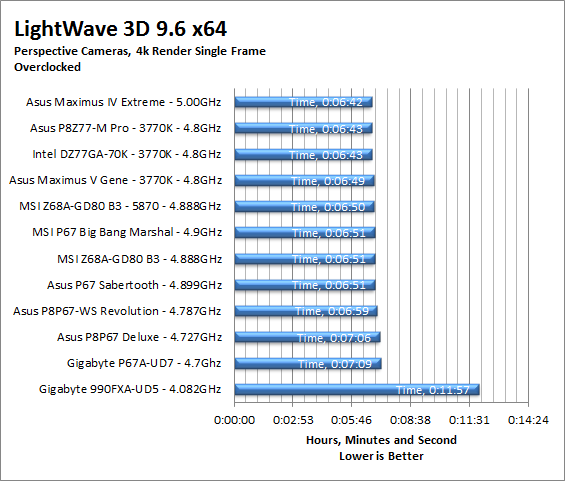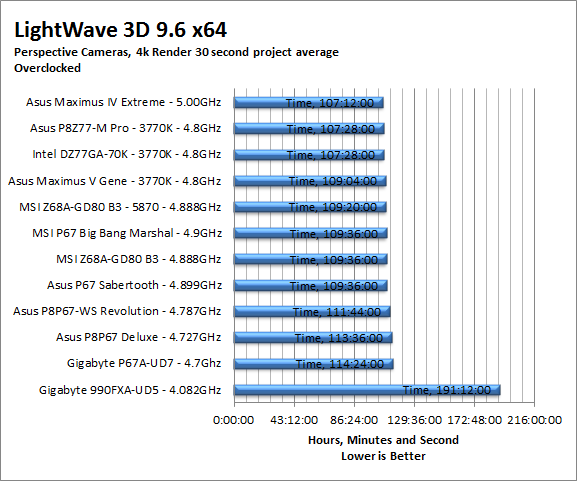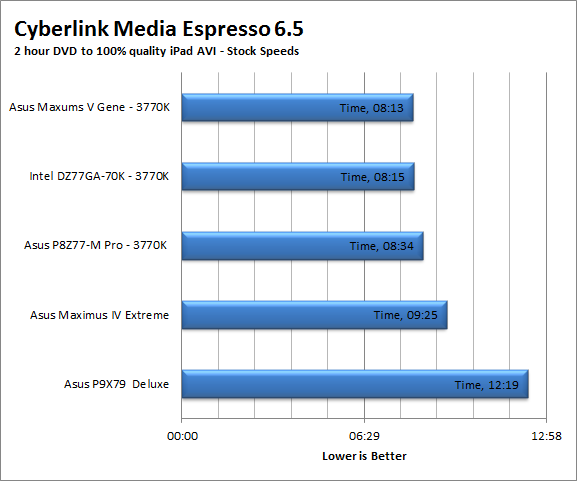Section III - Performance Tests,
Real-World
Here we have two tests that are designed to put the performance of the motherboard and its subsystems to the test. Both require good CPU, Memory, HDD and even to a lesser extent audio and network performance. The two tests we chose were Lightwave 3D 9.6 and AutoGK 2.55. We will be adding at least one more real-world test to this battery in the near future, but for now these two cover quite a bit.
Lightwave 3D 9.6 x64
Lightwave is another industry standard application for 3D animation and rendering. It has a large tool base and the rendering engine is highly threaded (when using the right render model). This application is also capable of expanding to 4k resolutions as well as ray tracing for rending the light sources. For our testing we use frame 470 of the Pinball scene found in the LW 9 Content folder. This uses the newer perspective camera that is better suited to a multi-CPU/Core environment. This camera style also uses ray tracing and a much improved anti-aliasing method. Settings are shown below in the attached screen shot. Of course these are single frame renders and they are not a complete picture; for that you have to take into account the number of frames an average project would have. In a typical 30 second commercial you will have around 840 to 960 frames (at 28 – 32 FPS) this means that you have to multiply the time of a single frame by that number just to get a vague idea of how long that 30 seconds would take. This is because each frame will have a different render time based on complexity.
Under the stress of LightWave 9.6 x64 the M Pro again shows that it is much faster than the P67 boards (when using an Ivy Bridge CPU). When overclocked to 4.8GHz it even manages to push past both of the other Z77 boards in the test group.


CyberLink Media Espresso 6.5 -
After having various issues with AutoGK and Intel CPUs with more than four cores we have changed our Media Encoding test to use Media Espresso from CyberLink. Although this new utility does not have the same ability to transfer directly from DVD it is still a good test to transfer different media types into a usable format for your iPad, iPod, or other media player. Our test involves using multiple (Six) 20 minute media files and transcoding them for an iPad. This gives us a very good indication of how well a motherboard can handle this type of work load.
In our transcoding tests with CyberLink’s Media Espresso we found that once again the Asus P8Z77-M Pro was a quick and nimble motherboard. It was able to crunch through our two hour video in about 8.5 Minutes which is simply amazing considering the time ratio here. Of course these times are also comparing Ivy Bridge to a Sandy bridge CPU. 
Motherboards
The Asus P8Z77-M Pro Brings Exceptional Performance and Value to the Lab - Performance - Real World
- Details
- By Sean Kalinich
- Hits: 73641
 At almost the opposite end of the spectrum from the Asus Maximus V Gene (in terms of target market) we find the Asus P8Z77-M Pro motherboard. The P8Z77-M Pro is also a micro ATX board and despite being aimed at the lower end of the consumer market it shares some of the same features that the Gene has. You still get Asus’ Digi+ power controls and FanXpert+ along with Asus’ commitment to solid design and component selection. We have talked about most of these items in Part I of our review. Now we are going to focus on the performance you can expect when you pick up the P8Z77-M Pro along with Intel’s new Ivy Bridge CPU.
At almost the opposite end of the spectrum from the Asus Maximus V Gene (in terms of target market) we find the Asus P8Z77-M Pro motherboard. The P8Z77-M Pro is also a micro ATX board and despite being aimed at the lower end of the consumer market it shares some of the same features that the Gene has. You still get Asus’ Digi+ power controls and FanXpert+ along with Asus’ commitment to solid design and component selection. We have talked about most of these items in Part I of our review. Now we are going to focus on the performance you can expect when you pick up the P8Z77-M Pro along with Intel’s new Ivy Bridge CPU.
Article Index
Page 6 of 8



